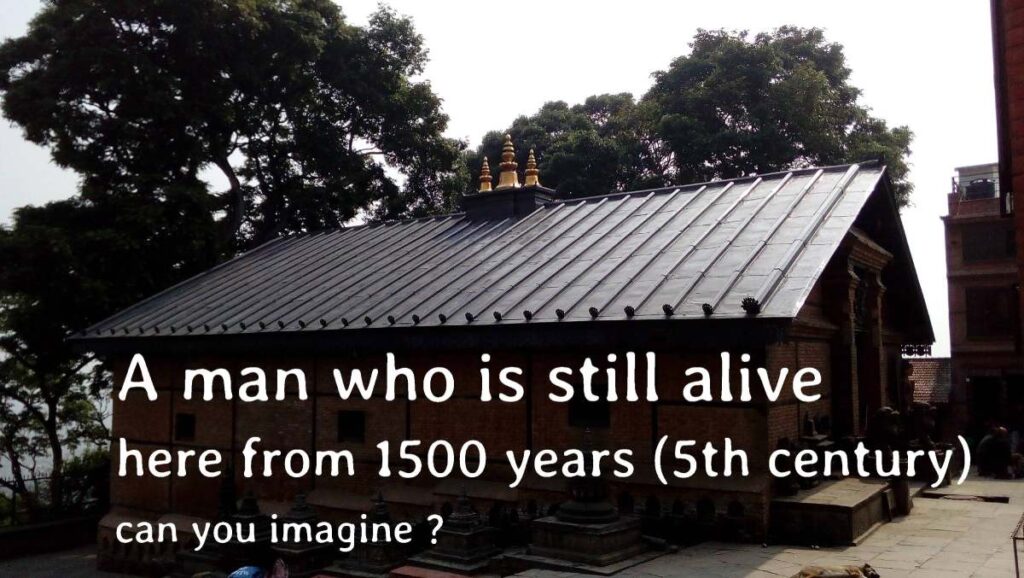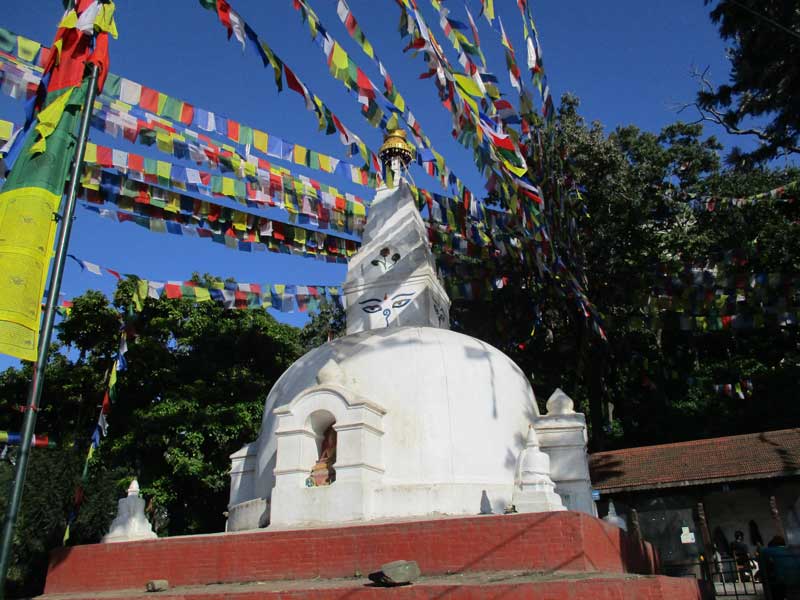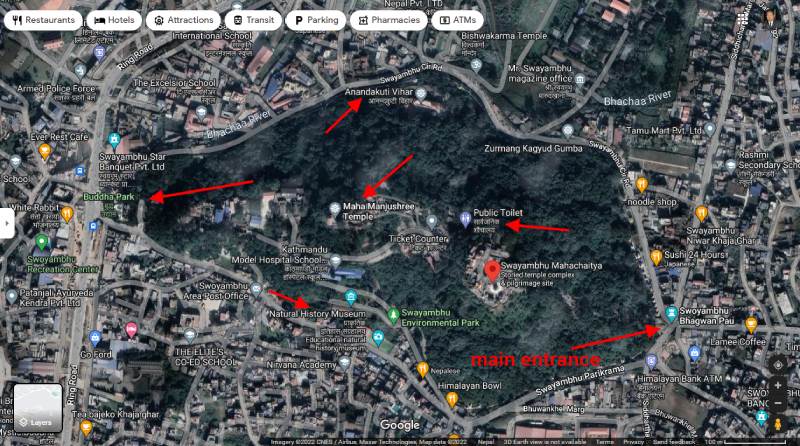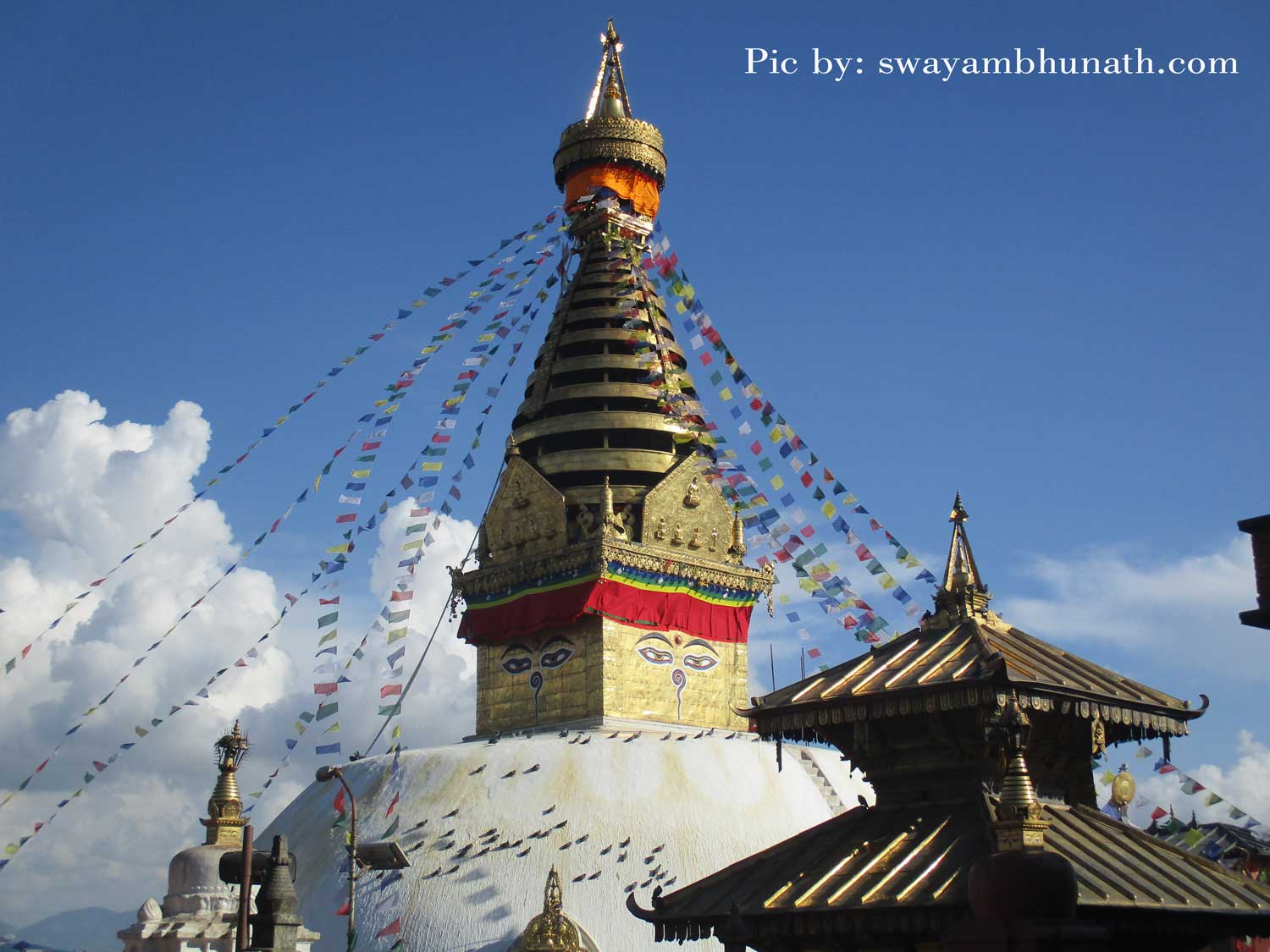About Swayambhu
Swayambhu stupa (Devanagari: स्वयम्भू) is located to the northwest of Kathmandu at the top of the green hill. The meaning of Swayambhu in Nepal Bhasa is ‘self-sprung’ or ‘self-manifested’. It is one of the holiest Buddhist shrines and is part of a UNESCO World Heritage since 1979. It is at least 1500 years old. It is also known as Swayambu, Swoyambhu and sometimes pronounce as shyambu or the monkey temple. Hindu and Buddhist devotees go around the Stupa for spiritual awakening, inner peace and blessing. To get on top of the pilgrimage, climb the 365 stairs from the front side which is the most recommended route that pilgrims take to enter Swayambhu on foot. You can take a taxi to the top backside of the stupa. From the backside, you’ll get to the top only after a few stairs. The boundary that separates Hindu and Buddhist is very blurred here as you’ll see a blend of Hindu and Buddhist which you may not see in other places of the world.
Mythology of Swayambhu
According to Swayambhu Purana (Buddhist scripture about the origin of Kathmandu valley and also provides information about the first and the second Buddhas in Buddhism), during the Golden age, the entire valley was submerged under water. Vipaswi Buddha heard about the lake and he arrived with his disciples at the lake which was also known as Taodhanahrada. They noticed that there are many plants but not a single lotus, so Buddha planted a lotus seed. Miraculous Lotus blossomed from the lake after eighty thousand years and the Swayambhu manifested himself in the form of an eternal self-existent flame, the Jyotipura over which a stupa was later built. Swayambhu means “Self-Created.”
Time passed by and one day an enlightened Manjushri became aware of the lake when he was doing meditation on a mountain named “Panchasira parvat”. He found the lotus with eternal self-existent flame. After realizing this in his meditation he left the place to worship it and headed towards Taodhanahrada, present Swayambhu. He found a beautiful place filled with an enormous lake. Then he cut a gorge at Chovar with his sword to drain water to the south, thinking the site would be more accessible to pilgrims. The scar can be still found at Chobar gorge. The water drained out of the lake and the valley was formed which is known as Kathmandu today.
After many years Shantikar Acharya who came to Nepal on pilgrimage thought it might become difficult to preserve the light in the future and requested guidance from Manjushree. Manjushri instructed Shantikar Acharya to build a chaitya over the flame to protect it, hence the stupa of Swayambhu was erected.
Symbolism of Swayambhu
The whitewashed dome at the base represents the earth and around the base of the stupa, on each of the four sides of the stupa, you’ll find the statues of the Panch Buddhas (five Buddhas or Five Tathagatas) which have it’s own meaning. It represents the 5 cosmic elements (ether, water, earth, fire and air) which were introduced by Vajrayana as embodiments of the five cosmic elements. Each Buddha strikes an identifying mudra(pose). In Nepal and Tibet Pancha Buddhas are the central features of Vajrayana Buddhism.
The Five Buddhas are:
- Vairochana वैरोचन (white color, ether) – occupies the center and is the master of the temple.
- Akshobhya अक्षोभ्य (blue color, water) – represents the cosmic element of consciousness and faces the east.
- Ratna Sambhava रत्नसम्भव (yellow color, earth) – represents the cosmic element of sensation and faces the south.
- Amitabha अमिताभ (red color, fire) – represents the cosmic element of Sanjna (name) and faces the West.
- Amoghasiddhi अमोघसिद्धी (green color, air) – represents the cosmic element of conformation and faces the north.
Architecture of Swayambhu
Swayambhu stupa is one of the scared ancient Buddhist pilgrimages which has a half sphere with a cube on top of it’s apex painted with the eyes of Buddha looking in all four directions. It is filled with numerous artifacts and we can find a thirteen-level golden spire. There are multiple shrines, temples, monasteries and museums. Each open side of the cube faces north, west, east and south. On top of the cube are 13 tiers which represent the stages of spiritual realizations needed for Buddhahood. There are carvings of the Panch Buddha (five Buddhas) on each of the four sides of the stupa. At the entrance, you will find two lion statues guarding.
History of Swayambhu
According to the Gopalarajavamsavali, it was founded by the great-grandfather of King Manadeva(464-505 CE), King Vrsadeva in Licchavi period about the beginning of the 5th century CE. There is a damaged stone inscription found at the site which confirms it and indicates that King Manadeva ordered work done in 640 CE. However, Emperor Ashoka is said to have visited the site in the third century BCE. He also built a temple on the hill which is believed to be destroyed later and the reason is unknown. It was damaged by the Muslim army that invaded in 1349 which was later repaired. After the main stupa was constructed, other monuments were constructed one by one in different periods by different dynasties and the eastern stairway is constructed in the 17th century by King Pratap Malla (the powerful king of Kathmandu). Yogin Sangye Gyaltsen added the wheel and spire in 1505 to the Swayambhu stupa’s dome.
The Shrines, Temples and places around the stupa
- Vajra dhatu mandala
- Pratappur and Anantapur
- Panchapur
- Harati Devi Temple
- Statue of Dipankara
- Monasteries
- Other
- Anandakuti Mahavihar
- Natural Historical Museum
- Swayambhu Environmental Park
Shantipur – this is a place where a man is still alive doing meditation from 5th century without food and water.

Why it is called “Monkey Temple” ?
It is called the monkey temple by tourists as this sacred pilgrimage site is also home to hundreds of monkeys in the forest. Maybe tourists visited there and saw lots of monkeys and started calling money them which was the easy pronunciation for them. It is believed that the monkeys in the Swayambhu reincarnated from the lice of Manjushri. He is among one of the Bodhisattvas. The name “Monkey Temple” was not given by local people. We think calling Swayambhu a monkey temple is wrong as it is the holiest Buddhist and Hindu religious site. It has both historical and religious importance.
Tourist Attractions in Swayambhu stupa
The main attraction is the white-domed Swayambhu stupa, besides that, there are numerous other ancient structures, Buddha statues, prayer wheels and flags that drive your attention. Swayambhu temple is a holy place for Buddhists and a very popular destination among foreign visitors.
City view: Swayambhu stupa is located at the top of the hill from where you can get the best view of Kathmandu. You can also view the city from a telescope which may be available at the top for a small fee. But we cannot guarantee that will be there at the time of your visit.
Forest: If you love nature then there is a small forest around the temple on the hills. You might have a good experience to be in a small forest in the city.
Sightseeing: This place is full of photogenic architecture and landscape, it is on the biggest hill near Kathmandu. You can get a beautiful scenic view of the entire Kathmandu city.
Buy gifts: You’ll find local handicraft products which is crafted by hand. You’ll find unique gift items.
Museum Visits: Statues from different centuries.
Photograph the surroundings: Beautiful place

Things to remember while visiting Swayambhu stupa
| Do | Don’t |
| You can freely move around. | It’s not advised to sit on the lap of Buddha’s statue for taking photos. |
| You can get a nice view of Kathmandu valley and the beautiful hills around. | Monkeys may attack you if you tease them. |
| It is not compulsory to buy anything there except a visitor ticket. | Entering the temple with shoes is not allowed but you can walk around the stupa with shoes. |
| Carry a lighter bag while visiting the Swayambhu temple as the temple has much more inclined around 365 steep stone steps. | Monkeys will try to grab your bag if they see food, drinks in your bag. |
| Please don’t throw pebbles, stones at monkeys. If you do so then a gang of monkeys will attack/bite you. | |
| It is not allowed to take photos inside the Harati temple. |
FAQ (frequently asked questions about Swayambhu)
What is Swayambhu famous for?
UNESCO World Heritage Site Swayambhu is famous for its historical temples.
Where is Swayambhu located?
Swayambhu is located in Kathmandu where you can get a taxi or public transport to reach there.
History of Swayambhu
Swayambhu is worshipped by both Buddhists and Hindus. It is one of the oldest religious places in Kathmandu, Nepal.
When was Swayambhu Stupa established?
It is founded at the beginning of the 5th century CE but according to Emperor Ashoka he said he visited the site in the 3rd century BCE.
Swayambhu pronunciation
You can pronounce it as swa-yam-bhu na-th, na-th or nath.
Swayambhū
Swayambhu eyes meaning
You will see three eyes on the Swayambhu stupa, between the two eyes you’ll see the third eye which is also known as Wisdom Eyes or tesro netra (third eye) in Nepali. Swayambhu eyes mean peace, the unity of all things existing in the universe.
Is it Free to visit Swayambhu stupa for tourists?
There is a small fee for entering Swayambhu for tourists. You’ll find the ticket counter at the top of the stairs just below the big bajra.
Best time to visit Swayambhu
Swayambhu can be visited anytime during the day as it is very easy to reach there.
Main Festivals of Swayambhu
The main festivals celebrated at Swayambhu: Gunla, Buddha Jayanti, Shree Panchami etc
Gunla: Gunla is a month long one of the most important festival celebrated in Swayambhu which is celebrated yearly from July to September (Nepali month Shrawan-Bhadra) playing traditional musical instruments. During the festival, devotees gather every morning with “Gunla baja” (traditional musical instruments). It is a period when the rainy season begins. During those days this season is an idle period as the paddy has been planted and farmers have free time. People engaged themselves in religious activities.
Buddha Jayanti: Buddha Jayanti is a Buddhist festival dedicated specifically to his birth, his enlightenment and his Mahaparinirvana (death). Buddha Jayanti is in April or May (Baishak in Nepali month) and it is also known as Buddha Purnima. During this day Swayambhu is decorated with prayer flags etc.
Shree Panchami: Shree Panchami also known as Basanta Panchami is celebrated in honor of the Goddess of learning and wisdom Saraswati. It is celebrated during January or February (Magh month in the Nepali calendar).
Entry fee for Swayambhu
Entry fee for foreigners – Nrs. 200 per person
Entry fo for SAARC Citizens – Nrs. 50 per person
How to reach Swayambhu ?
The site can be reached from the main entrance, 365 steps stairway and the first sight on reaching the top of the stairway is the big Vajra. There is another entrance also which is from the top of the hill to the east. There is a car road around the hill from the south leading to the southwest entrance. If you don’t have a habit of walking or have leg pain then you can use the path from the car parking which is easy as compared to the main 365 steps entrance.

Other places near Swayambhu:
- Bijeswori Temple
- Ichangu Narayan Temple
- Indrayani Temple
- Jamacho Temple
- Manang Samaj Himali Gumba
- National Museum
- Sainik Museum
- Shiva Puri and Nagarjun National Park
- Shova Bhagawati Temple

Nice post. I learn something totally new and challenging on blogs I stumbleupon everyday.
It’s always useful to read articles from other authors and use
a little something from other sites.
I like what you guys are usually up too. Such clever work and coverage!
Keep up the great works guys I’ve you guys to blogroll.